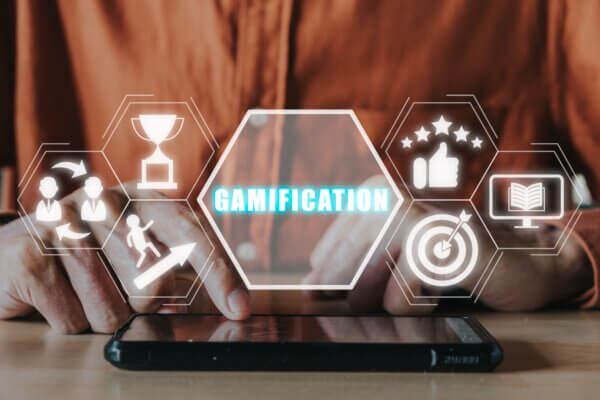Incorporating gamification in IT recruitment processes offers a dynamic approach to assessing candidates’ technical skills and problem-solving abilities, making the selection process engaging and efficient. By gamifying tasks such as coding challenges and simulations, recruiters can identify top talent.

- Understanding Gamification in IT Recruitment
- Principles of gamification in recruitment
- Benefits of Incorporating Gamification into the hiring process
- Challenges of incorporating gamification in IT recruitment
- Gamification Tools and Platforms
- Integrating IT Staff Augmentation with Gamification
- TL;DR: Summarising the role of gamification in IT recruitment
Let’s delve into the innovative realm of gamification and its profound impact on IT recruitment. From enhancing candidate experiences to refining assessment processes, we explore how gamification is reshaping the way companies identify and onboard talent.
In the ever-evolving landscape of Information Technology (IT) recruitment, traditional methods are being reimagined to attract top talent in a competitive field. Enter gamification, a dynamic approach that transcends the mundane confines of resumes and interviews. Thus offering a captivating gateway for both recruiters and candidates alike. As technology continues to advance, so too must our strategies for identifying and engaging with the brightest minds in the industry.
Join us as we navigate through the gamified terrain, uncovering its potential to revolutionize the recruitment process and pave the way for a more dynamic and inclusive workforce in the digital age.
Understanding Gamification in IT Recruitment
Gamification emerges as a strategic tool to captivate and evaluate potential candidates. It offers a dynamic approach to identifying top talent by transforming the hiring process into an engaging and interactive experience. Finally, it injects a sense of excitement and challenge into the hiring process, utilizing game-like elements to evaluate candidates’ skills and cultural fit. This approach ultimately leads to more effective hiring decisions.
Defining Gamification
Gamification in recruitment refers to the strategic integration of game-like elements and mechanics into the hiring process to engage and motivate candidates. It involves leveraging principles from game design, such as challenges, rewards, competition, and progression, to make the recruitment experience more interactive and enjoyable.
Through gamification, recruiters can enhance candidate engagement, assess skills and competencies more dynamically, and create memorable experiences that reflect positively on the employer brand. This approach fosters a sense of excitement and investment in the recruitment journey, ultimately attracting top talent and increasing the likelihood of successful hires.
Principles of gamification in recruitment
Let’s go over some of the basic principles of gamification in recruitment.

Engagement
Gamification, in the context of recruitment in IT, leverages game design principles to engage and motivate candidates throughout the recruitment process. The principle of engagement in gamification revolves around creating experiences that capture candidates’ interest, maintain their focus, and encourage active participation.
You can achieve engagement through a few ways, some of them include:
- Candidates can be presented with interactive challenges or simulations relevant to the IT role they’re applying for. These challenges could test technical skills, problem-solving abilities, or creativity, providing a more engaging and hands-on experience.
- There are elements of progression and growth due to gamification. Candidates may advance through different stages of the recruitment process, earning points, badges, or virtual rewards along the way.
- Introducing elements of competition or collaboration can make the recruitment process more engaging.
- Personalization can include customizing challenges based on candidates’ backgrounds, interests, and career goals. Thus making the experience more relevant and compelling to individual applicants.
Overall, the principle of engagement in gamification for IT recruitment aims to create a more dynamic and immersive experience for candidates. Thus ultimately attracting top talent and facilitating a more effective selection process. By incorporating elements of interactivity, progression, and personalization, gamification enhances engagement. Lastly, it encourages candidates to participate in the recruitment journey actively.
Motivation
Gamification leverages game design elements and principles in non-game contexts to engage users and drive desired behaviors. In the realm of recruitment in IT, applying gamification principles can significantly enhance motivation among candidates. By integrating aspects such as progress tracking, rewards systems, and competition, recruiters can create an interactive and immersive experience for potential hires.
For example, implementing coding challenges or technical quizzes not only evaluates candidates’ skills but also motivates them to showcase their abilities in a fun and competitive environment. Furthermore, incorporating progress badges or leaderboards fosters a sense of accomplishment and encourages candidates to strive for excellence.
Ultimately, gamification injects excitement into the recruitment process, boosting candidate engagement and motivation while also providing valuable insights for recruiters.

Realistic Simulations
Realistic simulation entails creating immersive experiences that mimic actual tasks and challenges encountered in the IT domain. Rather than relying solely on traditional methods like resumes and interviews, this approach integrates elements of gaming to assess candidates’ skills, problem-solving abilities, and adaptability in practical scenarios.
For example, applicants might be presented with simulated troubleshooting scenarios or coding challenges reflective of real-world IT issues. Through this process, recruiters gain deeper insights into candidates’ capabilities, allowing for more informed hiring decisions based on demonstrated performance rather than just qualifications on paper. Furthermore, candidates themselves benefit from a more engaging and interactive recruitment process that accurately reflects the demands of the IT field.
Feedback Mechanisms
Gamification utilizes feedback mechanisms to enhance the hiring process. By integrating elements of gaming, such as progress tracking, rewards, and competition, recruiters can provide candidates with immediate and constructive feedback. This feedback mechanism serves to engage candidates more deeply in the recruitment process. Thus fostering a sense of accomplishment and motivation as they advance through various stages.
For instance, candidates may receive feedback on their coding skills through gamified coding challenges, allowing them to see their strengths and areas for improvement in real time. By incorporating gamification, recruiters can not only attract top talent but also create an interactive and dynamic experience that facilitates better candidate engagement and decision-making.

Customization
Customization in the context of recruitment in IT refers to the tailored integration of gamification elements within the hiring process to suit the specific needs, preferences, and skill sets of both candidates and hiring organizations. In this approach, recruiters utilize gamified elements such as:
- personalized skill assessments,
- interactive challenges,
- and targeted feedback mechanisms
to engage candidates in a manner that resonates with their individual experiences and expertise.
For example, candidates may be presented with coding challenges or scenario-based simulations relevant to the particular role they’re applying for, allowing them to showcase their abilities in a familiar and engaging environment. By incorporating customization into gamification strategies, recruiters can not only attract top talent but also provide candidates with a more immersive and meaningful recruitment experience tailored to their unique profiles. Ultimately leading to more accurate assessments and better-fitting hires within the dynamic landscape of IT.
Accessibility
In this context, accessibility means making the recruitment process more approachable, inclusive, and enjoyable for a wider pool of applicants. This could involve utilizing interactive platforms or apps that simplify the application process, providing clear instructions and feedback, and offering opportunities for candidates to showcase their skills in a fun and interactive manner.
By incorporating elements such as progress tracking, badges, or rewards, gamification not only makes the recruitment process more transparent but also encourages active participation and fosters a sense of achievement among candidates, ultimately enhancing the overall candidate experience and attracting top talent to the IT sector.
For example, to enhance accessibility, the platform could offer flexibility in timing and accessibility, allowing candidates to participate in the recruitment process at their own pace and from any location with an internet connection. Additionally, the platform could provide accessibility features such as screen reader compatibility and language options to accommodate candidates with disabilities or those who speak different languages.
Diversity and Inclusion
Diversity and inclusion involve leveraging game mechanics and design elements to engage and motivate candidates from diverse backgrounds to participate in the hiring process. This approach aims to create a level playing field where individuals of varied demographics feel empowered and encouraged to showcase their skills and talents.
For instance, incorporating challenges, simulations, or interactive assessments into the recruitment process can provide candidates with different learning styles and experiences an equal opportunity to demonstrate their capabilities, regardless of their background or identity. By gamifying the recruitment process, companies can attract a more diverse pool of talent and foster an inclusive environment where everyone feels valued and respected.
Additionally, gamification can help mitigate unconscious biases in the hiring process by focusing on objective criteria and skill-based assessments rather than subjective judgments. Overall, gamification in recruitment for IT enhances diversity and inclusion efforts by promoting fairness, accessibility, and meritocracy in the selection of candidates.

Data Privacy and Security
Maintaining data privacy and security in a recruitment scenario that incorporates gamification principles for IT roles focused on data privacy and security involves several key strategies:
- Ensure that personal data collected from candidates during the gamified recruitment process is anonymized whenever possible.
- Utilize secure platforms and systems to host and manage the gamified elements of the recruitment process. Implement encryption and access controls to protect candidate data from unauthorized access or breaches.
- Put into place data retention policies to ensure that candidate data collected during the recruitment process is only retained for as long as necessary and securely disposed of once it is no longer needed.
By implementing these measures, organizations can ensure that data privacy and security are maintained throughout the gamified recruitment process.
Seamless integration with the recruitment process
You want to seamlessly integrate game-like elements into the recruitment process to engage and motivate candidates while assessing their skills and suitability for the job. This principle harnesses the psychological aspects of gaming, such as competition, achievement, and rewards, to make the recruitment process more enjoyable and interactive.
For example, recruiters can design coding challenges or IT-related quizzes that simulate real-world tasks, providing candidates with a hands-on experience of what the job entails. By incorporating gamification, recruiters can attract top talent, evaluate candidates’ technical abilities more effectively, and create a positive candidate experience. Ultimately leading to better hiring decisions and improved retention rates within the IT industry.
Benefits of Incorporating Gamification into the hiring process
Gamification in recruitment brings benefits to both job seekers and the company. Let’s go over them so that you can get a full picture of why this might be the right solution for you during your next hiring process.
For the job seekers
If you are a software developer looking for a job, gamification in recruitment may create a more engaging application process. Moreover, you may have an overall better user experience, due to gamification. Finally, if the gamification process is fun, you may be more motivated to participate. Let’s go over each of these in more detail.
Creating Engaging Application Processes
Gamification injects an element of fun and interactivity into the often mundane process of applying for a software developer position. By incorporating game-like elements such as challenges, puzzles, and quests into the application process, companies can captivate the attention of potential hires and create a more engaging experience.
For instance, candidates could be tasked with completing coding challenges or debugging exercises, with each successful completion earning them points or badges. This not only provides a glimpse into their technical abilities but also fosters a sense of achievement and progress.
Additionally, gamification encourages candidates to showcase their skills in a dynamic and competitive environment, making the application process more enjoyable while simultaneously helping employers identify top talent.

Enhancing User Experience with Gamified Assessments
Gamification is a potent tool for enhancing user experience within gamified assessments, injecting elements of fun, engagement, and motivation into what could otherwise be mundane or stressful tasks. By incorporating game-like features such as:
- points,
- badges,
- levels,
- and leaderboards,
gamified assessments can transform the experience into an interactive and enjoyable journey for users.
These elements provide users with clear goals to strive for, immediate feedback on their progress, and a sense of accomplishment upon completing tasks. Additionally, gamification encourages healthy competition among users, fostering a sense of community and collaboration. Through these mechanisms, gamified assessments not only make the process more enjoyable but also increase user participation, motivation, and ultimately, the effectiveness of the assessment itself.
Motivating Candidates through Gamification
Gamification is a powerful tool in motivating candidates within IT recruitment processes, injecting elements of competition and engagement into what can often be a daunting and rigorous journey. By incorporating gaming principles such as points, levels, and rewards, recruiters can infuse excitement and challenge into the application and assessment phases.
Through gamification, candidates are incentivized to showcase their skills and expertise in a dynamic and interactive manner, fostering a sense of achievement and progression as they navigate through various challenges. This approach not only keeps candidates actively engaged throughout the recruitment process but also provides valuable insights into their abilities and compatibility with the organization’s culture and values. Ultimately, gamification transforms the recruitment experience into a fun and memorable journey for candidates, enhancing their motivation and enthusiasm for joining the IT team.
For the hiring managers of a tech company
There are also numerous benefits for hiring managers of a tech company that uses gamification in recruitment. Some of these benefits include data-driven decisions, better insights into all skills, and automatic skill verification. Let’s explore the details of each of these down below.

Data-driven decisions during hiring
Gamification tools offer recruiters in the IT sector a dynamic platform to assess candidates’ skills and competencies objectively, facilitating data-driven hiring decisions. Through gamified assessments and challenges, recruiters can evaluate candidates’ problem-solving abilities, technical knowledge, and adaptability in real-world scenarios. These tools provide quantifiable metrics and performance analytics, allowing recruiters to measure candidates’ proficiency levels accurately.
Additionally, gamification fosters engagement and interaction, giving recruiters deeper insights into candidates’ personalities, teamwork skills, and work ethic. By leveraging data generated from these gamified assessments, recruiters can identify top talent efficiently, reduce bias, and make informed decisions aligned with the organization’s goals and requirements.
Better insight into not just technical skills but also soft skills
Gamification leverages game design elements and mechanics to engage users and motivate them to accomplish tasks. In the context of tech companies, incorporating gamification into training or assessment processes allows for a dynamic and interactive approach to evaluating both technical skills and soft skills. Through gamified platforms or applications, employees or candidates can showcase their technical prowess in simulated scenarios, solving problems and completing challenges.
Moreover, these platforms often integrate features that assess soft skills like teamwork, communication, problem-solving, and adaptability, as these are essential for success in any workplace environment. By providing real-time feedback and analytics, gamification enables tech companies to gain comprehensive insights into both the technical and soft skill proficiencies of individuals, facilitating more informed decisions in talent management, recruitment, and training strategies.

Automatic verification of the candidate’s skills
Gamification offers a dynamic solution to automating the verification of software developer skills, revolutionizing the hiring process. By integrating gamified assessments into recruitment platforms, employers can expedite candidate vetting while ensuring accuracy and reliability. Through interactive challenges, simulations, and coding exercises, candidates showcase their abilities in real time, providing recruiters with immediate insights into their proficiency levels.
This approach not only accelerates the hiring timeline but also effectively weeds out poor-quality candidates early on. By setting benchmarks and evaluating performance metrics within the gamified environment, recruiters can swiftly identify individuals who lack the requisite skills or demonstrate subpar capabilities, streamlining the selection process and enabling organizations to focus on top-tier talent acquisition.
Challenges of incorporating gamification in IT recruitment
Let’s go over some of the many challenges you may encounter when trying to incorporate gamification in recruitment. There are challenges for both the candidate and the company, check them out below.
Challenges for the candidate
One of the challenges for candidates when it comes to gamification is that the experience meets their expectations. Another challenge is that unfortunately, not all software developers may be willing to participate in recruitment games.
Hiring should meet the candidate’s expectations
Gamification in IT recruitment presents both opportunities and challenges. While incorporating game elements into the hiring process can potentially attract the best candidates by offering an engaging and interactive experience, it often falls short of meeting candidates’ expectations.
This discrepancy arises due to its relative rarity and the atypical setup of gamified recruitment processes. Candidates may expect traditional assessments rather than problem-solving challenges or interactive tasks. Moreover, if gamification is not properly executed, it can fail to accurately gauge problem-solving skills or provide meaningful insights into a candidate’s suitability for the role.
Ultimately, the effectiveness of gamification in IT recruitment hinges on its ability to strike a balance between novelty and functionality. It’s key to ensure that it enhances rather than detracts from employee engagement and the identification of top talent.

Software developers may not be willing to participate
Another challenge in gamifying IT recruitment lies in the reluctance of software developers to participate. Job applicants, particularly those in the tech sector, often prefer streamlined processes. This is due to their familiarity with efficiency and agility in their work environments. Gamification, while intended to engage candidates and inject fun into the hiring process, can sometimes backfire. In some cases it’s perceived as unnecessarily lengthy or convoluted.
Software developers, who are accustomed to quick iterations and rapid problem-solving, may find extended gamified assessments cumbersome and time-consuming. This reluctance to engage can create friction between the hiring team’s efforts to innovate recruitment methods and the candidates’ desire for efficiency. Therefore, striking a balance between gamification and brevity is crucial to ensure candidates play along willingly and effectively.
Challenges for the IT company
Now, let’s get into the challenges a tech company can face when trying to use gamification to recruit for job openings. One of these challenges is that gamification is expensive. Moreover, it can be time-consuming to create. Finally, it may give you false data about potential candidates.
Gamification requires a lot of resources
While gamification in recruitment seems like an interesting, out-of-the-box strategy in comparison to a dull recruitment process. It can be resource-intensive because creating these games can cost a pretty penny. Much like traditional hiring methods, for each type of candidate you need to create a new game. So for example you will need a different game for a JavaScript Developer than a Flutter developer. This is because one is a front-end developer, while the other is a mobile app developer. Not to mention for each candidate you need a separate test. It’s not likely you will only run one game for one job seeker, but rather multiple prospective employees.
It can be time-consuming to create
A key challenge for tech companies leveraging gamification in recruitment is the time-consuming nature of creating effective gamified experiences. Crafting engaging and meaningful games requires meticulous planning, design, and development, often involving multidisciplinary teams. From conceptualizing game mechanics to designing interactive elements and testing for user experience, each step demands significant time and resources. Moreover, ensuring alignment with the company’s culture and values adds another layer of complexity.
Balancing innovation with practicality while maintaining relevance in a rapidly evolving tech landscape further compounds the challenge. Thus, while gamification holds promise in enhancing recruitment processes, the investment of time and effort required to create compelling experiences remains a notable hurdle for tech companies.

Google & ChatGPT may do a lot of the work for your candidate giving you false data
A significant challenge for tech companies utilizing gamification in recruitment is the potential interference from platforms like Google and advanced AI systems such as ChatGPT. These technologies can inadvertently complete tasks or provide answers on behalf of candidates, leading to the submission of false data. Consequently, companies risk hiring individuals who may not possess the genuine skills or qualifications needed for the role. The reliance on gamified assessments, while innovative, demands careful consideration of potential pitfalls. In order to ensure the accuracy and integrity of the hiring process.
Gamification Tools and Platforms
Let’s explore some common gamification tools and platforms that you may consider using in your next hiring process. Some of these tools include Hackerrank, Coderbyte, and Codersignal.
Hackerrank
HackerRank is a popular platform used for competitive programming, coding challenges, and technical interviews. It offers a variety of programming tasks and challenges across different domains such as algorithms, data structures, artificial intelligence, and more. Users can solve these challenges in various programming languages and compete with others to improve their coding skills. Additionally, many companies use HackerRank to assess candidates’ coding abilities during the hiring process.
Coderbyte
Similar to HackerRank, Coderbyte provides a variety of challenges covering different programming concepts and difficulty levels. Users can solve these challenges in languages like JavaScript, Python, Ruby, and others. Coderbyte also offers resources such as tutorials and solutions to help users understand and improve their problem-solving skills. It’s a popular choice for individuals looking to enhance their coding abilities or prepare for technical interviews.
Codesignal
CodeSignal is yet another platform designed for practicing coding skills and preparing for technical interviews. It offers a range of coding challenges, including algorithmic problems, data structure exercises, and other programming tasks. One unique aspect of CodeSignal is its focus on gamification. This is where users can earn points, unlock achievements, and advance through different levels as they solve more challenges.
CodeSignal also provides features such as coding competitions, mock interviews, and personalized learning plans to help users track their progress and improve their coding abilities. Many individuals use CodeSignal as a valuable resource for honing their coding skills and preparing for coding interviews with companies.

Integrating IT Staff Augmentation with Gamification
Combining IT staff augmentation with gamification can be a strategic approach to attract and hire top-notch software developers. By leveraging staff augmentation services, companies gain access to a pool of skilled professionals temporarily. Thus allowing them to scale their teams according to project needs.
Introducing gamification techniques to the hiring process injects an element of fun and engagement. Therefore, enticing talented developers to participate in challenges, coding competitions, or interactive assessments. This not only evaluates their technical abilities but also provides insights into their problem-solving skills, creativity, and collaborative nature.
The gamified approach not only enhances the recruitment experience. But also helps identify candidates who are not only proficient but also passionate about their craft. Thus leading to the selection of the best-suited individuals for the job.

TL;DR: Summarising the role of gamification in IT recruitment
Gamification has emerged as a powerful tool in revolutionizing IT recruitment processes. It offers a dynamic approach to engage and assess candidates. By infusing elements of game design into recruitment tasks, companies can streamline their hiring processes. Moreover, they can automate candidate verification, and foster an engaging experience for potential hires.
The integration of gamification with staff augmentation further enhances the efficiency and effectiveness of IT recruitment efforts. For businesses seeking to optimize their hiring strategies and embrace innovative solutions, leveraging IT staff augmentation with gamification is the way forward. Ready to level up your recruitment game? Drop us a line to explore how you can harness the power of gamification and IT staff augmentation for your organization’s success.


Comments